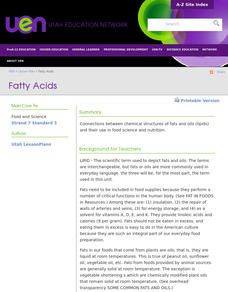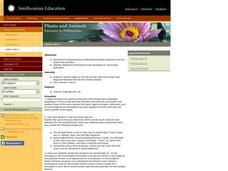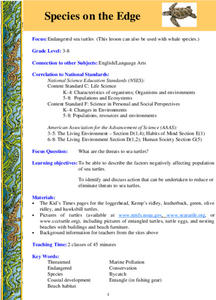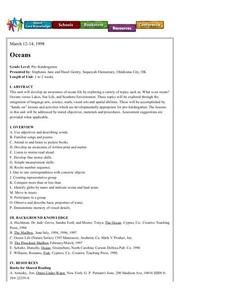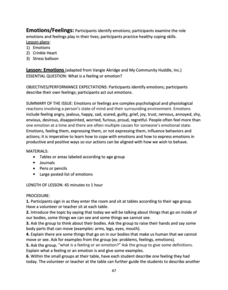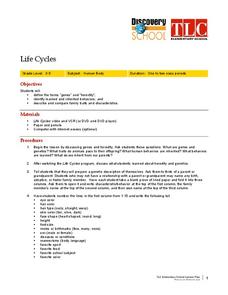Curated OER
"Exploring Shakespeare" An Introduction of Character and "Hamlet"
Students examine the literary terms "round character" and "characterization" through the play "Hamlet" by William Shakespeare. They view and discuss examples of clip art, video, and comic strips, and describe the character traits. ...
Curated OER
Winter Holiday Activities Extravaganza
Students define culture and explore elements that are part of the custom or culture of a place. In this holiday lesson, students identify the cultures they participate in. Students identify the differences in people's...
Curated OER
Fatty Acids
Identify the properties of fats and lipids. Compare the properties of saturated and unsaturated fatty acids Identify foods containing triglycerides and identify which foods contain saturated and unsaturated fat Discuss the function of...
Curated OER
Plants and Animals: Partners in Pollination
Students describe the complementary relationships between pollinators and the plants they pollinate, identify adaptations that flowers have developed to "encourage" pollination, and create and draw their own "designer" flowers.
National First Ladies' Library
Forming a League of Nations
Students identify and research the original language as composed by Woodrow Wilson in his League of Nations. Then they identify and describe the revisions of the original League of Nations as the United Nations was created. Students also...
Curated OER
Mr. Bo Jangle, What's Your Angle?
Third graders explore angles. For this geometry lesson, 3rd graders identify and define acute, obtuse, and right angles. Students form angles with their bodies, find angles in picture books, and record angles found outside in their math...
Curated OER
What Are the Signs and Symptoms of HIV Infection
Learners identify the symptoms of HIV. In this disease control lesson, students listen to a mini-lecture on the symptoms of HIV. Learners locate information on the Internet about ELIZA and confidentiality regarding HIV testing. Students...
Nemours KidsHealth
Puberty: Grades 3-5
Students discover the changes their body goes through during puberty by participating in a role-playing activity. In this human health lesson, students write a description of themselves as if they were a pituitary gland....
Curated OER
Species on the Edge
Students describe factors negatively affecting population of sea turtles, and identify and discuss action that can be undertaken to reduce or eliminate threats to sea turtles and other endangered species.
Curated OER
Oceans
Students become aware of the differences between ocean water and lake water by smelling, tasting and seeing. They distinguish between land and bodies of water on a globe and gain increased awareness of oceans and life.
Nemours KidsHealth
Breakfast: Grades K-2
Students investigate nutrition and the role breakfast plays in everyday life. In this healthy eating activity, students discuss their own breakfast habits and the meal they would prefer to have every morning. Students...
Curated OER
Squid Dissection
First graders participate in dissecting a squid. They identify and locate specific parts of a squid with teacher guidance. They draw a picture of what their squid looked like and label specific parts.
Curated OER
Speaking with Healthcare Professionals #3
Learners match the body parts with the verb that describes its function. They create complete sentences by using sentence strips to form a dialogue with a healthcare worker. They identify the parts of a sentence as well.
San Diego County District Attorney
Emotions/Feelings
Three lessons delve deep into the topic of feelings and the importance of expressing one's emotions. Through grand conversation, hands-on learning experiences, and reflective writing, scholars interpret the ups and downs of everyday...
Curated OER
“THE LORAX” by Dr. Seuss
Few children's books convey the message of conservation as well as Dr. Seuss' The Lorax. Read the story aloud, emphasizing the interconnectedness of plants and animals in an ecosystem and discussing different ways people can help...
TRAIN Educational & Community Services
Multicultural Activities
From catching stars developed by African pygmy tribes to chop stix pick-up or the Hanukkah dreidel, use this list of diverse multicultural activities to help your learners draw connections to unique cultures of the...
Curated OER
Safety wtih Animals
Students analyze animal feelings. In this personal health lesson, students examine the body language hints and sounds that dogs use to express their emotions.
Curated OER
Nonverbal Communication
Students observe a series of role plays by the teacher to illustrate how the body involuntarily shows how a person feels. They identify how certain skills are needed to develop and strengthen interpersonal relationships. Thus, students...
Curated OER
Life Cycles
Students identify inherited traits. In this heredity lesson, students watch a video and construct a genetic description of themselves.
Curated OER
A Class Divided
Students view a documentary about racism and discrimination against people of color. They discuss the film, identify ways in which they can combat racism, complete worksheets and consider how racial tensions are reflected in society.
Curated OER
Tableau
Second graders view a video from United Streaming and design still frames of important parts of a story. In this story-telling from different cultures lesson, 2nd graders understand general vocabulary about performing. ...
Curated OER
From Claws to Jaws: Atlantic Regions of the United States
Students explore New England, Mid-Atlantic, and southeastern regions of the United States. In this social studies thematic unit, students research a state and make a regional quilt. Students wrte a book report and read two novels...
Curated OER
Health Grade 3
Third graders understand what a friend is. In this lesson about friendships, 3rd graders analyze friend and non friend traits. Students learn about relationships through discussion in class. Students gather in groups and look at a list...
Curated OER
Comments WERD
Learners examine several examples of similes and metaphors, stating what is being compared. Then each student chooses a different person from the Civil War era and writes similes and metaphors that describe that person.




